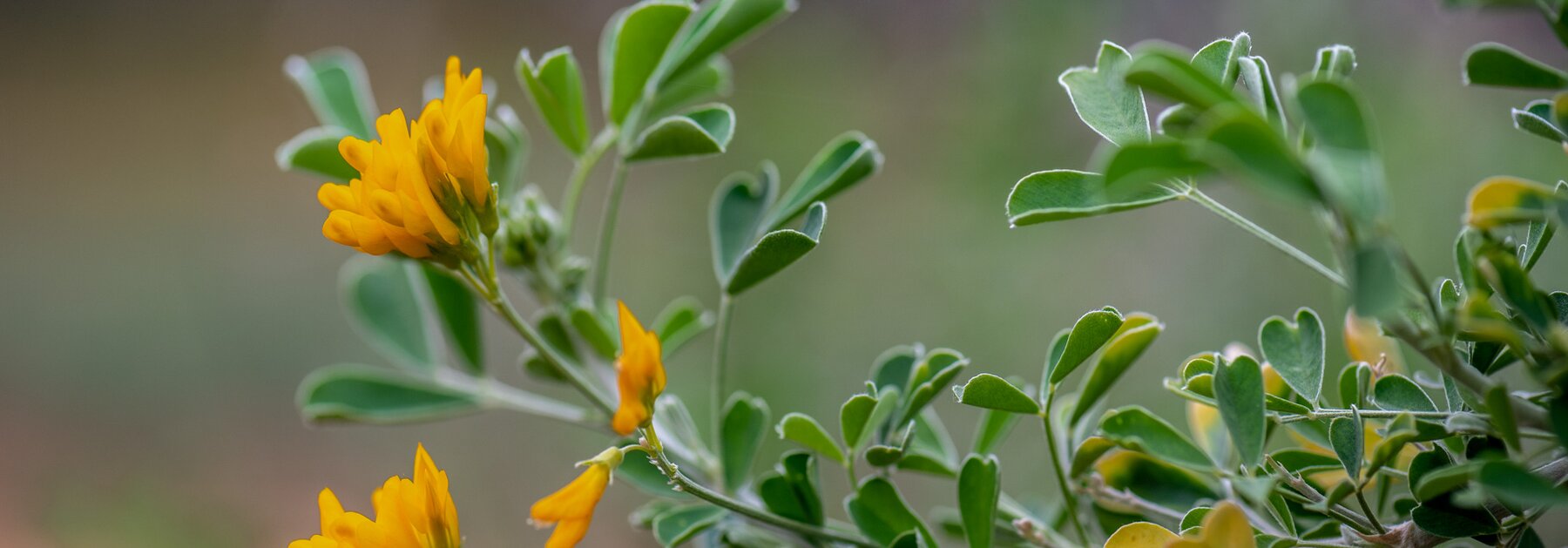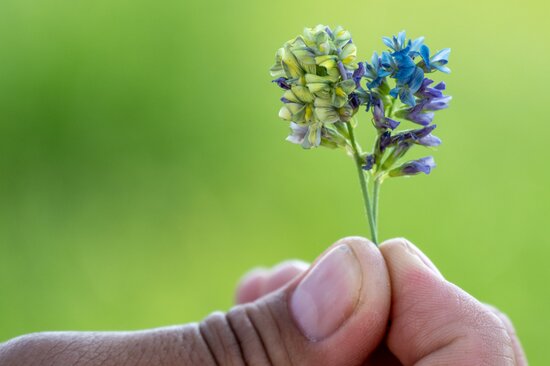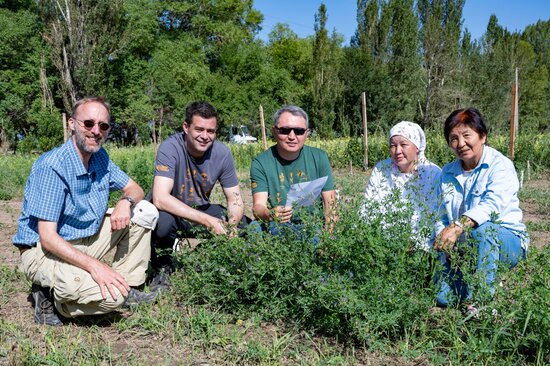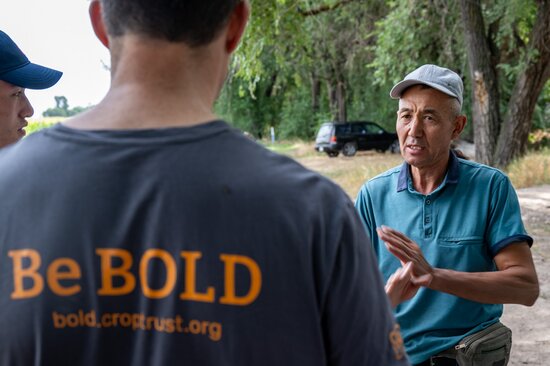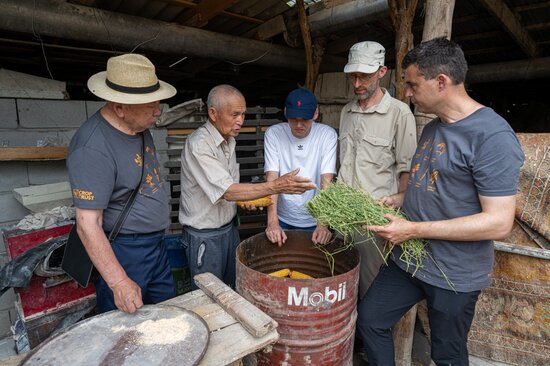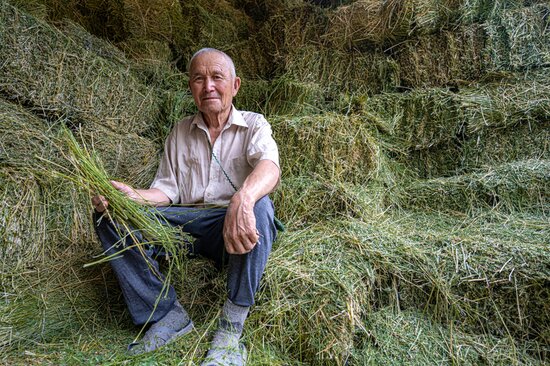Alfalfa
The BOLD Alfalfa Project
The BOLD alfalfa project uses wild relatives of alfalfa to improve the climate adaptation of the crop in Kazakhstan and Kyrgyzstan. Activities include identifying, acquiring, characterizing and regenerating diverse alfalfas and evaluating these and existing CWR-derived lines in partnership with smallholder farmers. These new genetic materials will be used to develop new alfalfa varieties, which will be evaluated using participatory farmer models, and distributed using seed-sharing schemes.
Why alfalfa?
Alfalfa (Medicago sativa L.) is an important and broadly adapted forage crop that is grown for forage, hay and silage in more than 80 countries on 30-35 million hectares. Its deep taproot allows it to use water that is stored deep in the soil profile, giving it tolerance to drought. As a legume, it also contributes to enhancing soil fertility and its perennial growth habit helps protect the soil from erosion, improves soil structure and acts as a carbon sink.
Alfalfa produces more digestible energy and protein per hectare than most crops and is also an important source of vitamin A and of 10 other vitamins.
Challenges
Alfalfa grows under a wide range of conditions, but growth rates drop sharply if the temperature exceeds 35° C or is lower than 10° C. The declining availability of water from glacial ice melt in key production areas of Central Asia has increased the need for new varieties that are more efficient at utilizing soil water that is available at the beginning of the growing season when air temperature is still cool, while also maintaining or improving levels of drought, heat and cold tolerance.
Cold tolerance, or winter-hardiness, is a challenge for the northern regions of Asia, where temperatures can reach −40° C. Wild relatives of alfalfa have evolved to survive in these environments, and are being used in breeding to develop varieties that can survive in these harsh environments while still being productive in the growing season.
Building on the Crop Wild Relatives Project
The BOLD alfalfa project builds on the work done on the crop under the Crop Trust's Crop Wild Relatives (CWR) Project, “Adapting Agriculture to Climate Change: Collecting, Protecting and Preparing Crop Wild Relatives.” This developed drought-tolerant pre-breeding lines derived from alfalfa wild relatives and evaluated them in diverse environments in Kazakhstan, China and Chile. This material is now being used to make plant selections to develop advanced breeders’ lines and future CWR-derived plant varieties.
The alfalfa CWR project also developed a seed-sharing scheme in Inner Mongolia, China, marking the first successful commercialization of an CWR-derived alfalfa cultivar in this region. It also worked with farmers in Chile to plant alfalfa fields and extend knowledge of best practice establishment methods.
Project partners
- South Australian Research and Development Corporation, Australia (lead)
- Kazakhstan Research Institute of Agriculture and Plant Growing, Kazakhstan
- Kyrgyz Research Institute of Livestock and Pastures, Kyrgyzstan
Activities
- Identify alfalfa germplasm with climate adaptation traits in genebanks world-wide (including partner genebanks)
- Conduct field evaluation trials to evaluate CWR-derived lines of alfalfa developed under the CWR Project in partner countries
- Evaluate CWR-derived lines in Kazakhstan and Kyrgyzstan farming systems that are transitioning from irrigated to rainfed agriculture
- Characterize CWR accessions, CWR-derived lines and interspecific crosses for saponin contents as a basis to understand the potential of alfalfa to reduce enteric methane emissions from ruminant livestock
- Characterize the genetic diversity of wild alfalfa using genetic markers
- Assist and provide training to forage breeders in Kazakhstan and Kyrgyzstan, including the use and management of bees for pollination, seed production agronomy, and the application of new data recording applications such as GRID Score (James Hutton Institute)
- Develop new varieties of alfalfa based on elite CWR-derived lines from the CWR Project
- Characterize and evaluate CWR genebank accessions for traits of interest
- Make pre-breeding lines available for use with a standard material transfer agreement from the Australian Pastures Genebank, and evaluation data available on the James Hutton Institute Germinate platform
Alfalfa resources
Crop Trust stories
- A BOLD Future for Alfalfa: More with Less Water. 13 September 2023
- An Alfalfa That Loves the Cold. 23 April 2023
- Crop Science Special Issue Shows Why Crops Need to Get Wild. 25 January 2021
- Greener Grows the Alfalfa in Chile. 19 August 2021
- Honeybees Sweeten the Deal for Kazakhstani Alfalfa Farmers. 16 June 2021
- Five Standout Messages from “Into the Wild” at GLF Climate. 23 November 2021
- New Alfalfa Varieties Take Root. 7 May 2020
- Patagonian Farmers Welcome Climate-Resistant Alfalfa. 14 July 2020
- Alfalfa, Queen of Forages: Reconquering the Grasslands of Inner Mongolia. 12 December 2018
- Alfalfa Pre-breeding: Spotlight on Alan Humphries. 5 September 2018
- In Search of the Elusive Sea Medick on Georgia’s Black Sea Coast. 25 September 2017
Relevant publications
-
Ovalle, C., Espinoza, S., Barahona, V., Gerding, M., Humphries, A., del Pozoet, A. 2015. Lucerne and other perennial legumes provide new options for rainfed livestock production in the Mediterranean-climate region of Chile. Ciencia Investigacion Agraria 42: 465−478.
- Wang, Y., Yu, L., Li, J., Sun, J., Xie, J. 2016. Effects of chilling stress on the root characteristics of 5 alfalfa varieties. Acta Agrestia Sinica 1: 101−106.
- Wang, Y., W., Li, J., Yu, L., Yuan, T., Yang, Z. 2017. The morphology indexes of different alfalfa cultivars in northwest of HeBei. Heilongjiang Animal Science and Veterinary Medicine 8: 175−176, 298−299.
- Meiirman, G.T. 2017. On the use of wild species in recurrent selection for enhancing the adaptability of cultural varieties of alfalfa [in Russian]. Biotechnology, Genetics and Plant Breeding 29−30: 48−50.
- del Pozo, A., Ovalle, C., Espinoza, S., Barahon, V., Gerding,. M., Humphries, A. 2017. Water relations and use-efficiency, plant survival and productivity of nine alfalfa (Medicago sativa L.) cultivars in dryland Mediterranean conditions. Journal of Agronomy 84: 16−22.
- Espinoza, S., Barahona, V. 2017. Nueva alternativa para producción de forraje en períodos de escasez alfalfa en condiciones de secano mediterráneo. Ficha Técnica INIA Raihuen Praderas 3.
- Galiolla, M., Serik, K., Sakysh, Y., Serik, A., Saltanat, T. 2017. Results of selection studies of alfalfa based on inbred lines. Agricultural Science and Technology A 7: 309−316.
- Sun, J., Yu, L., Zhao, J., Liu, H., Zhang, Y. 2017. Effects of heterogeneous root zone salinity on plant growth and ion characteristic in alfalfa. Scientia Agricultura Sinica 50(22): 4299–4306.
- Humphries, A., Ovalle, C., del Pozo, A., Inostroza, L., Barahona, V., Ivelic-Saez, J., Yu, L., Yerzhanova, S., Meiirman, G. Abayev, S., Brummer, E., Hughes, S., Bingham, E., Kilian, B. 2018. Introgression of alfalfa crop wild relatives for climate change adaptation. In: Basigalup, D., del Carmen Spada, M., Odorizzi, A., Arolfo, V. (eds). Proceedings. Second World Alfalfa Congress, Cordoba, Argentina. 11–14 November, 2018. Buenos Aires, Argentina: Instituto Nacional de Tecnología Agropecuaria (INTA). pp. 72–76.
- Ji, R., Yu, L., Bai, S. 2018. Effects of colchicine on chromosome doubling of Medicago sativa L. cv. Jinda. Journal of Northwest A & F University – Natural Science Edition 46(1):103–110.
- Wang Y.T., Yu L.Q., Yang Z.M., Wang C.J. Yan L.L., Ge J., Dong X.F. 2018. Germination characteristics of 10 alfalfa varieties under Na2CO3 stress. Pratacultural Science 35(6): 1443–1450.
- Sun, JuanJuan, A, LaMuSi, Zhao, JinMei, Xue, YanLin, Yu, LinQing, Yu, Zhu, Zhang, YingJun. 2019. Analysis of amino acid composition and six native alfalfa cultivars. Scientia Agricultura Sinica 52(13): 2359–2367.
- Inostroza, L., Espinoza, S., Barahona, V., Gerding, M., Humphries, A., del Pozo, A., Ovalle, C. 2020. Phenotypic diversity and productivity of Medicago sativa subspecies from drought-prone environments in Mediterranean type climates. Plants 10(5): 862. https://doi.org/10.3390/plants10050862
- Toktarbekova, S.T. kyzy, Meiirman, G.T., Yerzhanova, S.T., Abayev, S.S., Umbetov, A.K. 2020. Productivity of the green mass of new alfalfa cultivars depending on the effect of macro- and microfertilizers on various phosphorous backgrounds. Journal of Ecological Engineering, 21(2): 57–62.
- Inostroza, L., Ovalle, C., Del Pozo, A., Espinoza, S., Viviana, B., Gerding, M., Humphries, A. 2019. High-throughput phenotyping based on canopy reflectance and RGB-images for selecting drought tolerant alfalfa in rainfed Mediterranean environments. In: Huguenin-Elie, O., Studer, B., Kölliker, R., Reheul, D., Probo, M., Barre, P., Feuerstein, U., Roldán-Ruiz, I., Mariotte, P., Hopkins, A. (eds). Improving sown grasslands through breeding and management. Gatersleben, Germany: European Association for Research on Plant Breeding. pp 327–329.
- Humphries, A.W., Ovalle, C., Hughes, S., del Pozo, A., Inostroza, L., Barahona, V., Yu, L., Yerzhanova, S., Rowe, T., Hill, J., Meiirman, G., Abayev, S., Brummer, E.C., Peck, D.M., Toktarbekova, S., Kalibayev, B., Espinoza, S., Ivelic-Saez, J., Bingham, E., Small, E., Kilian, B. 2021. Characterization and pre-breeding of diverse alfalfa wild relatives originating from drought-stressed environments. Crop Science 61: :69–88.
- Innes, L.A., Denton, M.D., Dundas, I.S., Peck, D.M., Humphries, A.W. 2021. The effect of ploidy number on vigor, productivity, and potential adaptation to climate change in annual Medicago species. Crop Science: 61: 89–103.

